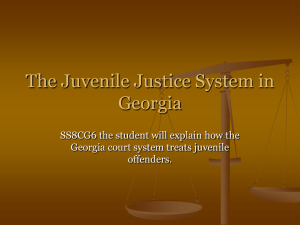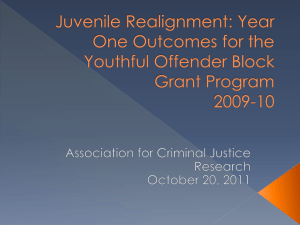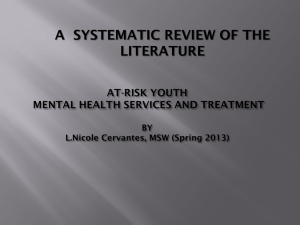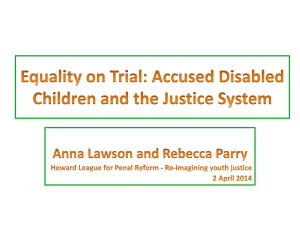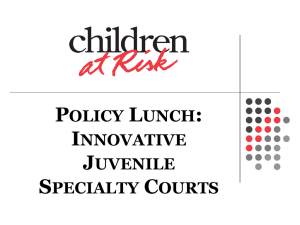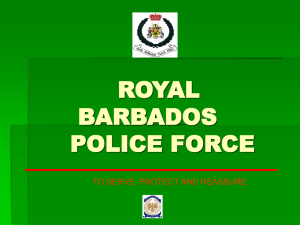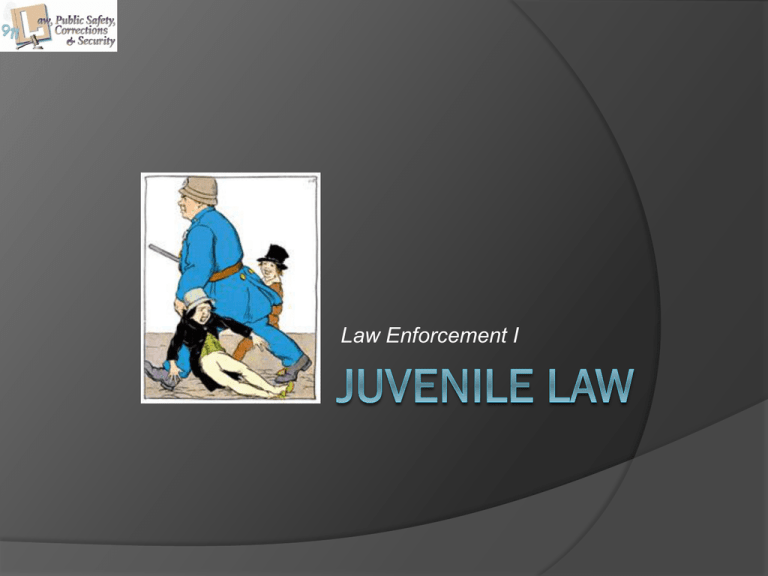
Law Enforcement I
Copyright and Terms of Service
Copyright © Texas Education Agency, 2011. These materials are copyrighted ©
and trademarked ™ as the property of the Texas Education Agency (TEA) and
may not be reproduced without the express written permission of TEA, except
under the following conditions:
1) Texas public school districts, charter schools, and Education Service Centers
may reproduce and use copies of the Materials and Related Materials for the
districts’ and schools’ educational use without obtaining permission from TEA.
2) Residents of the state of Texas may reproduce and use copies of the
Materials and Related Materials for individual personal use only, without
obtaining written permission of TEA.
3) Any portion reproduced must be reproduced in its entirety and remain
unedited, unaltered and unchanged in any way.
4) No monetary charge can be made for the reproduced materials or any
document containing them; however, a reasonable charge to cover only the
cost of reproduction and distribution may be charged.
Private entities or persons located in Texas that are not Texas public school
districts, Texas Education Service Centers, or Texas charter schools or any
entity, whether public or private, educational or non-educational, located
outside the state of Texas MUST obtain written approval from TEA and will
be required to enter into a license agreement that may involve the payment
of a licensing fee or a royalty.
Contact TEA Copyrights with any questions you may have.
Copyright © Texas Education Agency, 2011. All rights reserved.
Images and other multimedia content used with permission.
2
What happens when a child is
reported to law enforcement?
Parents reporting a runaway, an abusive
child, a child on drugs, an unruly child,
or their child’s criminal activity
School personnel reporting juvenile
delinquent activity or conduct in need of
supervision
Copyright © Texas Education Agency, 2011. All rights reserved.
Images and other multimedia content used with permission.
3
What happens when a child is
reported to law enforcement?
(continued)
Community officials, such as county
commissioners or anyone employed by
the county, reporting delinquent conduct
or conduct in need of supervision
Concerned citizens reporting the same
type of activity
Victims reporting offenses against their
persons or property by juvenile
offenders
Copyright © Texas Education Agency, 2011. All rights reserved.
Images and other multimedia content used with permission.
4
Providing Warning Notices
A warning issued by law enforcement to
a juvenile is similar to a citation
It is a warning to make the juvenile
aware that law enforcement has
observed or been made aware of
questionable conduct
The warning gives the law enforcement
officer a legal reason to stop and
question that juvenile if suspected of
committing the same act in the future
Copyright © Texas Education Agency, 2011. All rights reserved.
Images and other multimedia content used with permission.
5
Providing Warning Notices
(continued)
The Juvenile warning must
Be in accordance with department standards
(not just one single officer’s method of
controlling kids)
State the juvenile’s identification and the
type of warning issued
Include the date and time of the alleged
offense
Be in writing and limited to one per juvenile
per event
Copyright © Texas Education Agency, 2011. All rights reserved.
Images and other multimedia content used with permission.
6
What must occur prior to
taking a child into custody?
Probable Cause
○ Must exist before an officer may take any
person into custody, much less a juvenile
○ Exists when a law enforcement officer has an
articulable reason to believe,
1. that unacceptable conduct had been
committed or was about to be committed
2. by the juvenile offender
Copyright © Texas Education Agency, 2011. All rights reserved.
Images and other multimedia content used with permission.
7
What must occur prior to
taking a child into custody?
(continued)
Mere suspicion
○ A belief that a child is guilty of a crime or looks
like he or she may be committing or about to
commit a crime, is not enough to justify taking
a child into custody.
○ Suspicious activity does provide an officer
with legal grounds to stop and question an
individual. This, however, does not constitute
a detention.
Previous criminal activity by a juvenile
does not constitute probable cause or
suspicion.
Copyright © Texas Education Agency, 2011. All rights reserved.
Images and other multimedia content used with permission.
8
When can a child be taken
into custody?
A juvenile court order
Custody pursuant to the laws of arrest
Probable cause exists leading a law enforcement
officer to believe that a criminal offense or conduct
in need of supervision has occurred
A juvenile who is in violation of probationary
requirements is taken into custody by juvenile
probation based on probable cause
Pursuant to a directive to apprehend from any
legal court
Copyright © Texas Education Agency, 2011. All rights reserved.
Images and other multimedia content used with permission.
9
What is a Directive to
Apprehend?
Authorization of any law enforcement to
take a child into custody
Probable cause must be determined by
the court
Juvy version of an arrest warrant
Copyright © Texas Education Agency, 2011. All rights reserved.
Images and other multimedia content used with permission.
10
What is the difference between temporary
detention and taking into custody?
If an officer stops a juvenile driver and then
smells marijuana, the officer has the probable
cause to temporarily detain the juvenile, even to
the point of using handcuffs.
safety of the juvenile and the officer
officer may conduct a search for the marijuana
Car or person
The officer does not have probable cause to take
the juvenile into custody - yet - but does have
probable cause to search
Copyright © Texas Education Agency, 2011. All rights reserved.
Images and other multimedia content used with permission.
11
What is the difference between temporary
detention and taking into custody?
(continued)
If the officer discovers a large bag of marijuana.
At that point the officer has probable cause to
believe that the juvenile is in possession of the
marijuana due to the fact that the juvenile is in
care, custody, and control of his or her car.
Therefore, the juvenile could be taken into
custody.
Copyright © Texas Education Agency, 2011. All rights reserved.
Images and other multimedia content used with permission.
12
What is the difference between temporary
detention and taking into custody?
(continued)
An exception - another individual in the car
confesses that they were the owners of the
marijuana.
The probable cause for custody would then switch
to the person confessing to the possession.
Copyright © Texas Education Agency, 2011. All rights reserved.
Images and other multimedia content used with permission.
13
What is the difference between temporary
detention and taking into custody?
(continued)
However, The officer has probable cause to take
the juvenile into custody as a child with conduct
in need of supervision under the influence of the
drug
At this point the officer may
release the juvenile to a parent or other responsible adult
or
take the juvenile directly to a juvenile processing facility
where he or she will be referred to juvenile probation as a
child with conduct in need of supervision.
Copyright © Texas Education Agency, 2011. All rights reserved.
Images and other multimedia content used with permission.
14
Taking a child into custody
Once a child is in custody the law
enforcement officer must transport the
child directly to a juvenile processing
facility
From the moment a child is taken into
custody the clock starts ticking
A child can only be held in custody by
law enforcement for a total of six hours
Parents must be notified, if possible.
Copyright © Texas Education Agency, 2011. All rights reserved.
Images and other multimedia content used with permission.
15
What is a juvenile processing
facility?
It is an office or room in a police station,
sheriff’s office, or school office that is
○ Certified and approved by the local juvenile
board
○ Used for temporary detention only
○ Not a cell or holding facility used for other
types of detention
Copyright © Texas Education Agency, 2011. All rights reserved.
Images and other multimedia content used with permission.
16
What happens at a juvenile
processing facility?
(continued)
The child
○ Must not be held longer than six hours
○ Is never left unattended
○ Is entitled to be accompanied by a parent,
guardian, or the child’s attorney
○ Has the right to private consultation, for a
reasonable period of time, at any time during
his or her temporary detention, with the child’s
parents or attorney
Copyright © Texas Education Agency, 2011. All rights reserved.
Images and other multimedia content used with permission.
17
What happens to a child
while they are in custody?
The necessary state forms are completed
The child might be photographed and
fingerprinted
Copyright © Texas Education Agency, 2011. All rights reserved.
Images and other multimedia content used with permission.
18
Fingerprinting and
Photographing
A child may not be photographed or
fingerprinted without consent of the local
juvenile board unless the child is taken into
custody for a Class B Misdemeanor or
greater
Voluntary written consent from a parent or
guardian
Other fingerprints exist and the officer has
probable cause to believe that the
juvenile’s prints may match the existing
prints
Copyright © Texas Education Agency, 2011. All rights reserved.
Images and other multimedia content used with permission.
19
Fingerprinting and
Photographing
(continued)
A juvenile runaway may be printed and
photographed
Prints and photos are not available to the
public
All information concerning a juvenile, if the
juvenile is not referred, must be destroyed
within ten days subsequent to the custody
of the juvenile
Copyright © Texas Education Agency, 2011. All rights reserved.
Images and other multimedia content used with permission.
20
Taking a child into custody
(continued)
After processing,
juvenile probation may order the child
1. Released to Parents or
2. into a local juvenile detention facility to
protect the child from harming him or
herself or others
At this point the child must have a
hearing in the juvenile court within 48
hours to determine if further detention is
required or whether further processing is
required
Copyright © Texas Education Agency, 2011. All rights reserved.
Images and other multimedia content used with permission.
21
What happens to a child
while they are in custody?
(continued)
The child will receive a magistrate’s
warning (if the magistrate is available)
State The charges against him.
Includes Miranda type warnings
○ The child can terminate questioning at any time
Police are then free to question child.
Copyright © Texas Education Agency, 2011. All rights reserved.
Images and other multimedia content used with permission.
22
Juvenile Confessions
What
a juvenile tells law enforcement,
subsequent to questioning from law
enforcement, cannot be used against
a juvenile
To
be admissible, statements must be
written.
Copyright © Texas Education Agency, 2011. All rights reserved.
Images and other multimedia content used with permission.
23
What happens after a written
confession?
One of the following events must occur:
Release the child to a parent or guardian
Bring the child before the juvenile
processing office
Take the child to a juvenile detention facility
Take the child to a secure detention facility
Take the child to a medical facility
Dispose of the case without referral
Copyright © Texas Education Agency, 2011. All rights reserved.
Images and other multimedia content used with permission.
24
2 Types of Juvenile conduct
Conduct indicating a need for
supervision (CINS)
Class C misdemeanor (other than a ticket)
Truancy (unexcused Absences from school
for 10 days in 6 mos. Or 3 days in 4 weeks.)
Runaway
Conduct involving fumes (glue, paint, etc)
Conduct that gets her expelled a 2nd time
Violating a court order
Subject to fine or Probation
Copyright © Texas Education Agency, 2011. All rights reserved.
25
2 types of Juvenile conduct
Delinquent conduct:
Crime punishable by confinement
Contempt of court
Intoxication offenses
○ DWI
○ Assault
○ Manslaughter
Subject to confinement
Copyright © Texas Education Agency, 2011. All rights reserved.
26
Status Offender
Some laws apply only to juveniles
Truancy
Runaway
Student misconduct
Curfew violation
A status offender is a child who is
charged with conduct that would not be
a crime if he were an adult.
These crimes do not result in
incarceration
Copyright © Texas Education Agency, 2011. All rights reserved.
27
Juvenile Court
Each county shall have a juvenile court.
It can be combined with other courts
Copyright © Texas Education Agency, 2011. All rights reserved.
28
Right to Attorney
Child has a right to an attorney at every
stage
Child cannot waive that right in the more
serious hearings
Court can order parents to pay for an
attorney if they can afford it
Court can appoint an attorney if parents
cannot afford it, at govt expense
Copyright © Texas Education Agency, 2011. All rights reserved.
29
Guardian Ad Litem
The court appoints a guardian ad litem
to represent the child’s best interest if:
There parents do not appear in court; or
The parents are not protecting the child’s
best interest.
Child’s attorney may also act as Ad
Litum.
Copyright © Texas Education Agency, 2011. All rights reserved.
30
1st Offender Program
Arresting Officer can refer 1st time
offender into program if:
Conduct does not involve a prison felony,
violence or a weapon.
No prior delinquent conduct
Child & parent agree
Avoids Juvenile court
Disposition includes
Restitution, community service, training,
probationary reporting
Completion means no juvenile court
Copyright © Texas Education Agency, 2011. All rights reserved.
31
Deferred Prosecution
May be available to the child
Probationary period cannot last more
than 1 year.
Conditions can include training, rehab,
restitution.
Parents must agree
Copyright © Texas Education Agency, 2011. All rights reserved.
32
Teen Court
Available for class c misd.
Must waive 5th amend rts
Def. must request it
Allowed only once every 2 years
Upon completion, the case is dismissed.
Copyright © Texas Education Agency, 2011. All rights reserved.
33
Detention Hearing
Held within 2 working days of arrest
Evidence is usually by written report
The court can seal evidence the child
should not hear.
The child will be released unless:
The child may flee
Parents are not caring for child
He may be a danger
Has a previous record and is likely to offend
again
Release may have conditions attached
Copyright © Texas Education Agency, 2011. All rights reserved.
34
Transfer to Criminal Court
Juvenile court may decide to treat the
child as an adult by moving the case to
criminal court if:
Probable cause exist to believe child
committed a felony
Child was 14 or more at time of a 1st deg.
Felony, Agg. Drug felony or Capitol Felony
Child was 15 or more for lesser felonies
“because of the seriousness of the offense
alleged or the background of the child the
welfare of the community requires criminal
proceedings.”
Copyright © Texas Education Agency, 2011. All rights reserved.
35
Transfer to Criminal Court (cont.)
Court shall consider:
Violent nature of crime
Maturity of child
Previous record
Likelihood of rehabilitation
Once convicted as an adult, always an
adult
Copyright © Texas Education Agency, 2011. All rights reserved.
36
Adjudication hearing (Trial)
Guilt/not guilty phase of trial
Jury allowed
Burden is Beyond a reasonable doubt
Question is “whether or not the child has
engaged in delinquent conduct or
conduct indicating a need for
supervision.”
If no – free to go.
If yes – proceed to Disposition hearing
Copyright © Texas Education Agency, 2011. All rights reserved.
37
Disposition Hearing
Separate [punishment] hearing
1st issue decides whether further action is
required.
Is the child is in need of rehabilitation
Does the protection of the public or the child
requires that disposition be made
If no – child is guilty but goes home (rare)
Copyright © Texas Education Agency, 2011. All rights reserved.
38
Disposition Hearing (cont.)
2nd
issue is what to do with the child.
Probation, with conditions
○ 2 yr min. for felony
○ May remove child from the home as a
condition
○ Must end on 18th b-day, unless case is
transferred to adult court
Felony Delinquent conduct - Commitment
to Texas Juvenile Justice Department
Copyright © Texas Education Agency, 2011. All rights reserved.
39
Punishment ranges
Felony 3rd – 9 mos. - 10 year
Felony 2nd – up to 20 years
Felony 1st
Agg drug felony – up to 40 years
Capital offense
Punishment is progressive
All youth receive treatment.
success affects time served.
By 19, child is transferred to TDC
Most are put on parole after release.
Copyright © Texas Education Agency, 2011. All rights reserved.
40
Resources
Texas Juvenile Law Fourth Edition: Robert
O. Dawson & Bryant Smith University of
Texas School of Law
Texas Juvenile Law Fourth Edition 1997
Supplement: Robert O. Dawson & Bryant
Smith University of Texas School of Law
Office of Juvenile Justice and Delinquency
Prevention http://www.ojjdp.gov/
Texas Juvenile Probation Commission
http://www.tjpc.state.tx.us/
Copyright © Texas Education Agency, 2011. All rights reserved.
Images and other multimedia content used with permission.
41


